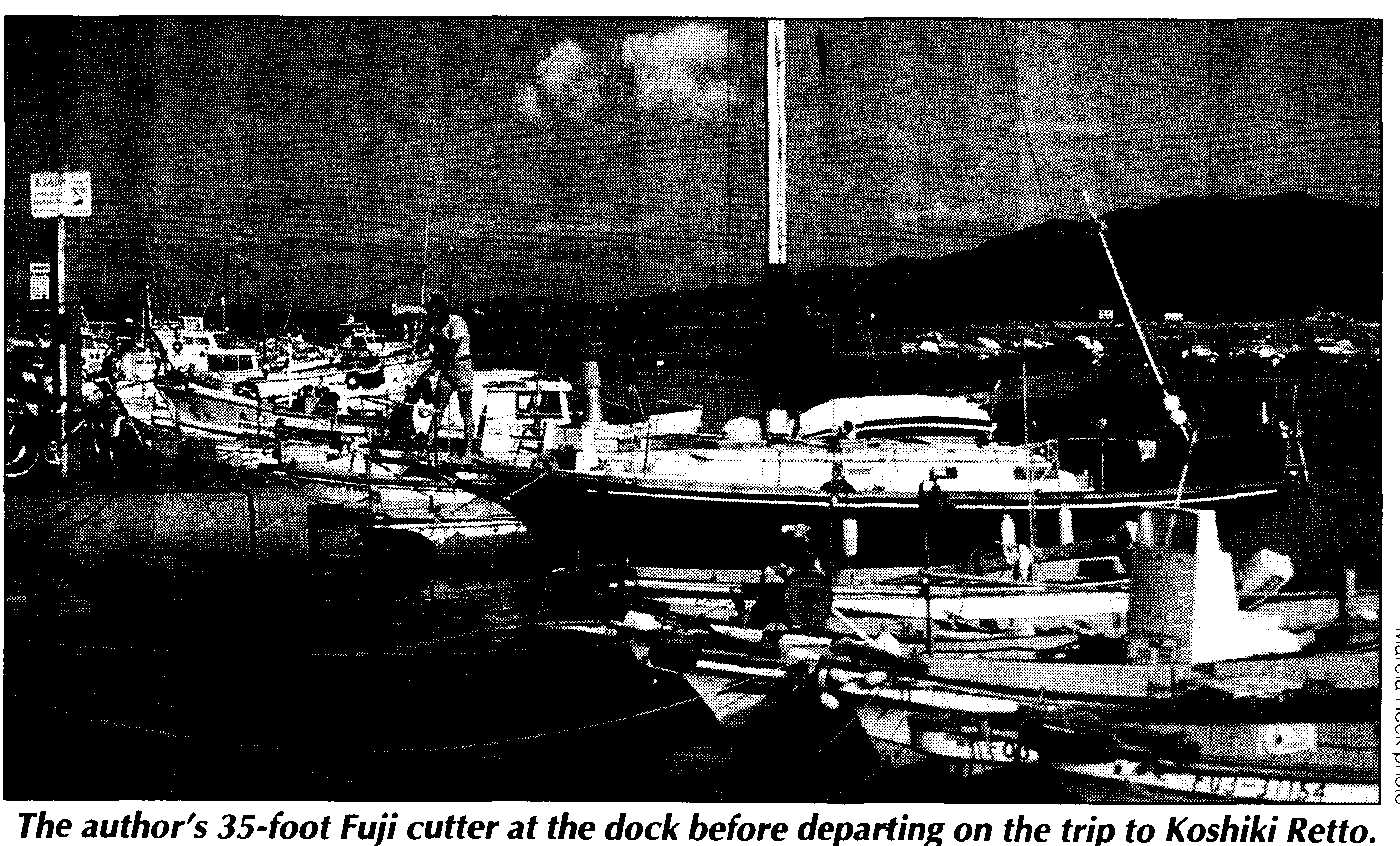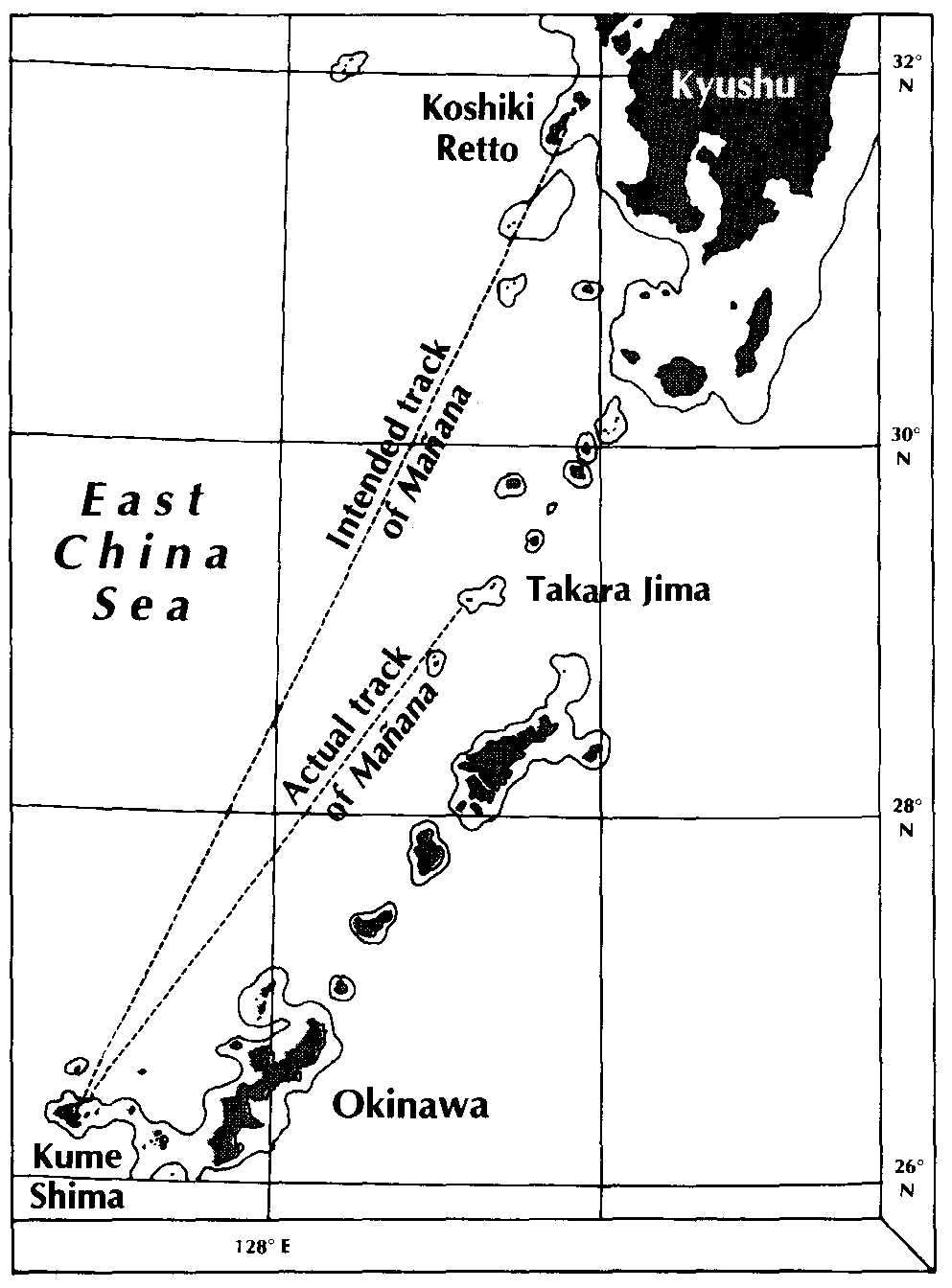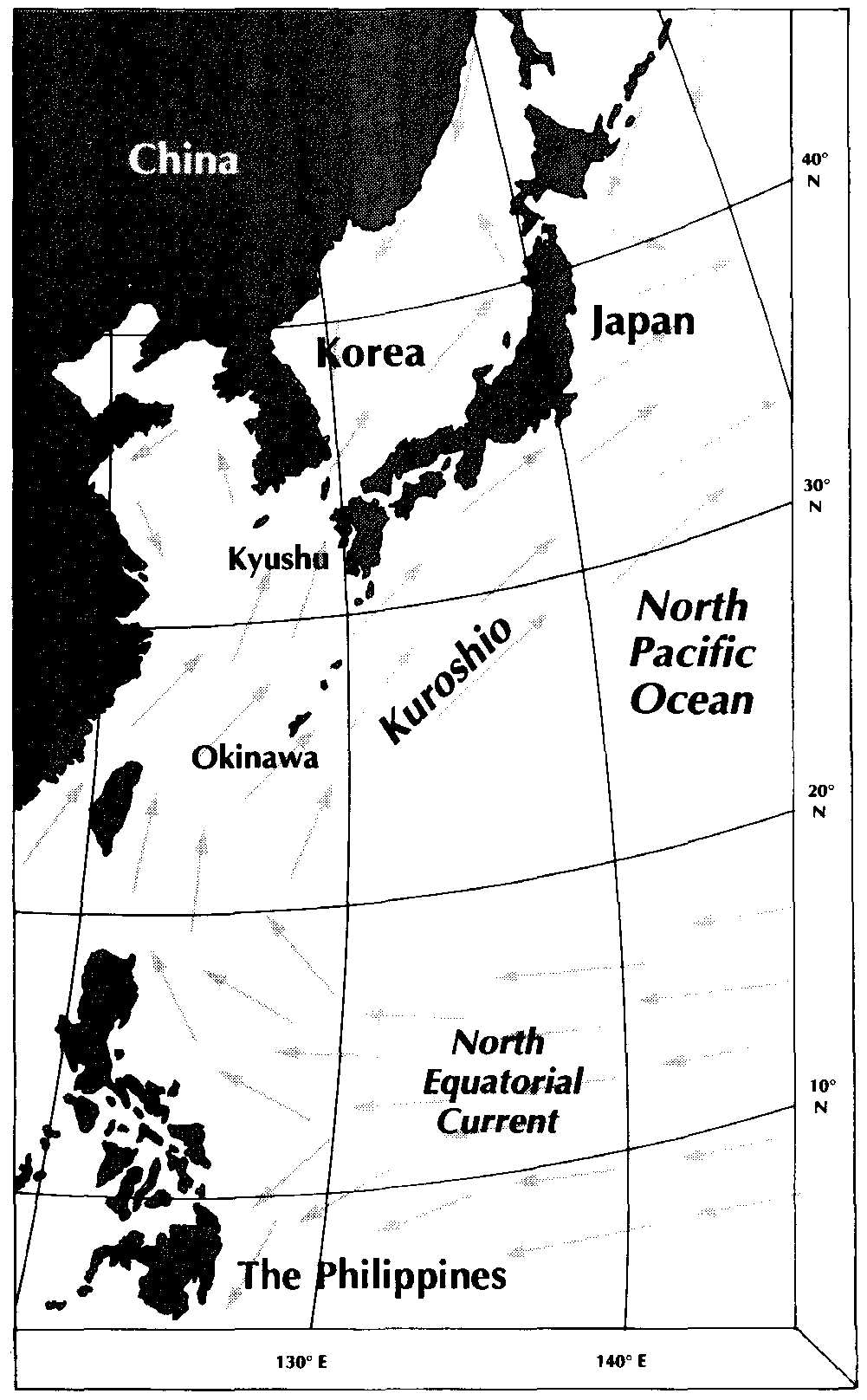Ocean Navigator No. 40 :June 1991
Black Current - Bad weather and big seas force voyagers to run for cover in the Japanese islands
by Marcia Reck
Contributing editor Marcia Reck has been sailing the Pacific with her husband Dave since 1985. Their next leg is north to the Aleutians.
Call it the Kuroshio and it doesn’t sound too bad. Indeed, it is regarded as friendly by the residents of the West Coast of the U.S. whose climate is warmed by its remnants. But translate its Japanese name to English and you have “Black Current.” That sounds decidedly less benevolent.
This swift current has its beginnings near the Philippine Islands as an offshoot of the North Equatorial Current. It flows at up to five knots past Taiwan and on to southern Japan. The main branch heads east, between the Ryukyu Islands and Kyushu, then scatters itself out into the North Pacific.
Since we started voyaging in Japanese waters, we’ve met the Black Current on half a dozen occasions. The encounters have rarely been to our advantage. Like a black cat slinking across our path, the current seems to bring us had luck. Since the average sailing speed of Mańana, our 35- foot cutter, is around five knots under either power or sail, trying to proceed against this current’s usual two- to three-knot set is no picnic. However, our worst experience with this current occurred when it was running more or less with us.
The passage, an intended 320-mile sail from Kume Shima to Koshiki Retto, started benignly enough. In light easterlies, we motor-sailed out, through the pass in Kume Shima’s fringing reef. We rounded the western tip of the island, then set a course to the northeast. The breeze swung southeast and increased to around 10 knots. We shut down our 25-horsepower Westerbeke engine and sailed comfortably towards Koshiki Retto. Within an hour things began to go wrong. What started as a light drizzle soon turned to steady rain. Shortly thereafter, our southeast wind became a northeasterly and we could no longer lay our course. Guessing that a stationary front we had believed to be well northeast of us had slid down over our heads, we decided our best bet was to alter course for a well-protected harbor we knew of on Okinawa. We’d arrive around midnight, but there were lights to check our position and a place where we could anchor until daylight.
An hour later, the wind was out of the east southeast. Reaching Okinawa was now out of the question. We again laid a course for Koshiki Retto. Wet and disgusted after two hours of going nowhere, we were beginning to get the feeling that this wasn’t going to be one of our better passages.
By the next morning we were sure of it. The night had been a trying one. Much of it had been spent peering into rainy darkness and dodging fishing boats. They had popped up as if by magic just after dark. It was as if they’d lain submerged during daylight hours. Throughout the day the rain continued. The wind varied from east to southeast, which should have allowed us to sail off the wind. However, we seemed to have picked up a north- setting current. Only by sailing 20 degrees high of the course for Koshiki Retto could we maintain that course over the bottom. The seas were sloppy, with swells coming from several directions. We weren’t having fun.
 The author and her husband found fishing harbors in Japan to be very well protected.
The author and her husband found fishing harbors in Japan to be very well protected.
Cold rain in the face
I envied Motor, the ship’s cat. As I huddled beneath the dodger, I could see him asleep on the leeward settee, snuggled down into a blanket. He was very warm, very dry. I, despite several layers of clothing and foul weather gear, shivered from the cold and damp. Just as I’d begin to warm up, I’d have to force myself to stand up and have a look around for other vessels. Cold rain in the face would start me shivering again.
Conditions did not improve. By midnight we were beating into a 20- knot east northeasterly. To make matters worse, the wind was continuing to back. By dawn, we couldn’t lay Koshiki Retto. In fact, we couldn’t hold a course to any Japanese territory to the north of us. And we had no desire to sail to Korea.
About 35 miles southeast of us lay the small island of Takara Jima. To say the charts we had of the island were sketchy is being generous. The sailing directions spoke only of a roadstead anchorage open to the north. Yet sailing friends had visited the island the previous year and had found a protected fishing harbor; indeed, they had ridden out the end of a tropical storm there.
Our choices were to heave-to and wait for a wind shift or to make a run for what we hoped was shelter. The most recent weather forecast we’d copied mentioned that same stationary front, stretching out to the west of us into mainland China. The chances of the wind shifting soon didn’t look good. Meanwhile, we’d get blown back south. We decided that if we had to lose some northing, we should at least get a good night’s sleep out of the deal. Without delay, we altered course for Takara Jima.
The weather continued to deteriorate. The wind had picked up to 30 to 35 knots and the rain had increased. If we’d thought we were miserable before, we had no idea what to call our present state. The worst of it was the seas. We still had that north- setting current which we by then recognized as the Kuroshio. With the wind blowing directly counter to the stream, the seas got very ugly very quickly. We had them on the beam, in the cockpit, over the cabin top.
As we fell off those square waves, things began to break loose below. Lockers flew open. Plastic containers of beans and grains were launched across the cabin at Motor who was cowering on the opposite settee. He no longer looked smugly content. When I scrambled below to try to close the lockers, I noticed a large puddle of water on the galley counter- top. I found that I’d left the vent above the stove open. I closed this and mopped up the water. Minutes later, I again went below to check our position on our SatNav. The lake was back again. This was a leak like we’d never experienced before, but since hanging on was about all we could manage, it would have to keep leaking until we got to calm water. About 10 miles out, we spotted Takara Jima. The seas were as before, but the rain and wind had slackened. For five hours we’d sailed almost due south, but had made good a course of around 135 degrees.
Searching for a harbor
As we approached the island, we debated where to search for the fishing harbor. Instinct told us to look on the north shore where the Sailing Directions and our chart indicated the location of the road- stead anchorage. It should be the most sheltered spot and therefore the most logical place to build a fishing harbor. However, both Dave and I thought we remembered our friends mentioning the harbor as being on the southeast side. As the information had been in a letter read nearly a year before, neither of us was too ready to trust our memories.
We set a course to bring us just to the east of the northeast tip of the island. As Takara Jima is only about three miles long, we should be able to see much of the east coast and, we hoped, see the signs of a fishing harbor if there was one available to take refuge in.
 The author had intended to sail to the island of Koshiki Retto, south of Kyushu. But adverse winds forced them to divert to the smaller island of Takara Jima where they searched for a harbor of refuge.
The author had intended to sail to the island of Koshiki Retto, south of Kyushu. But adverse winds forced them to divert to the smaller island of Takara Jima where they searched for a harbor of refuge.
Close-in, the seas became a hit more reasonable. Looking down along the east coast, we saw nothing to indicate a harbor. Along the north shore we began to make out seawalls and a small village. Our spirits rose. Struggling to hold binoculars and ourselves steady in the still rolling swells, we studied the land ahead, searching for an opening. Our spirits slid again. Seawalls, yes; but nothing to indicate shelter behind them. They appeared to be close inshore and seemed to be protection for land, not for vessels. With our poor charts, we didn’t want to get in too close, hut we thought we were close enough to he able to see the tops of fishing boats if there were any. To one side of the roadstead lay a ferry, but although it was in behind a breakwater, it leaped about in the swell. No protection there for tiny Mańana.
Hearts sinking, exhaustion overwhelming us, we motored around the northwest point of the island. The west coast opened in front of us. It was rockbound with no sign of habitation. As the steep, rugged south point approached, we could see that it, too, held no hope of shelter. We feared our only choice was to heave to in the relative lee of the island long enough to at least cook and eat a hot meal and to clean up some of the mess. Then we’d have to rejoin the battle. But as we discussed this course of action, we both noticed something that made us resolve to comb the island inch by inch until we found that illusive harbor. Looking south, Dave said, “Hey, I didn’t know there was another island just south of here!” A glance at the chart told us there wasn’t. What looked like solid land ahead proved to be moving when studied closely. We were looking at huge waves as big as houses—no, make that fivestory apartment blocks— marching across the horizon. The wind was slicing the top off the north-setting current and whipping it up into huge waves. No way did we want to give those monsters another go at us.
Going in close
Tail now firmly between our legs, we turned north again. This time we crept in close to the seawalls. The depths proved to be no problem—we found ourselves in comfortable water between 20 and 25 feet deep. Just as we began to feel we dared go no further, a long empty concrete wharf appeared to port. It was sheltered from the wind and much of the swell. We both heaved sighs of relief and prepared to tie alongside the wall. But there were more surprises to come. Barely had the words “we can tie up over there” escaped our lips when we realized there was an inner harbor behind the wharf. If someone had asked at that moment where paradise lay we’d have pointed to port.
 The powerful Kuroshio Current—similar to the Atlantic’s
Gulf Stream—emerges from the North Equatorial Current near the
Philippines and then proceeds north, sweeping by the island of Okinawa and the
other islands south of japan, before turning
east and slowing down as it crosses the North Pacific.
The powerful Kuroshio Current—similar to the Atlantic’s
Gulf Stream—emerges from the North Equatorial Current near the
Philippines and then proceeds north, sweeping by the island of Okinawa and the
other islands south of japan, before turning
east and slowing down as it crosses the North Pacific.
Hiding in there was a snug harbor, blasted from the fringing reef and surrounded by walls so high that the raised outriggers of the fishing fleet were hidden from sight from seaward. One of the first constants we’d learned about sailing in Japan was: “If there is a fishing village, there will be a well-protected harbor.” It had proved true once again.
This particular harbor had bonuses. Unlike most, it wasn’t crowded and the water was crystal clear. We crept forward, still leery of the unknown depth, but our depth sounder read a steady 15 feet. With many gestures, a group of fishermen on the inner seawall showed us where to drop a stern anchor and then secured our bowlines. We felt as if we’d come home after a long, hard journey.
Belowdecks the fun wasn’t over. The cabin looked like ground zero. Books, charts, clothing and water were jumbled together on settees and on the sole. A little investigation revealed two serious leaks; the one in the galley and another in the fore- peak. Each had let in several gallons of water. The v-berth cushions were soaked, as was much of the food stored in the galley lockers.
Both leaks proved to be the result of our carelessness. If there is a danger in easy, fairweather passages, it is in the lax attitude they foster. We’d had a string of calm passages and forgotten all too quickly just how necessary it is to be sure that the vessel is always ready to take whatever the ocean dishes out. We hadn’t prepared Mańana for the seas that cascaded across her decks. The open vent over the stove was the most minor of our sins of omission. The forepeak leak had been caused by our failure to disconnect the anchor chain and properly plug the hawse hole. It wasn’t the first time we had forgotten to do this, but a long period had elapsed since the last slip-up and we’d forgotten just how messy the results could be.
The galley leak had been the result of one of those strange slips in established shipboard routine that occur when exhaustion sets in. As the wind increased that morning, Dave dropped the mainsail and we ran along under working jib alone. For some unknown reason, he hooked the halyard to the port lifeline, which he had never done before and won’t likely do again. When he tightened up on the halyard, the force ripped the brace of a nearby stanchion out of the deck, leaving four screw holes and an inch-long crack. Torrents of water had rushed down these holes to be flung past the locker doors and onto the galley counter and sole by Mańana’s violent motion.
Although the belief that a black cat brings ill luck is a land superstition, it seems to hold for us at sea as well. The cat just disguises itself as a current. This time, the Kuroshio interacted with the wind to produce monstrous waves that forced us into port. Next time we cross paths with the Black Current we intend to he prepared.